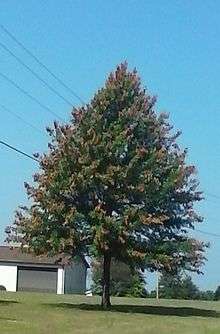Brood V
Brood V is one of 12 separate broods of periodical cicadas that emerge as adults once every 17 years in North America. They are expected to appear in the eastern half of Ohio, the southwestern corner of Pennsylvania, the upper two-thirds of West Virginia less the Eastern Panhandle, far western Maryland, and some places in Virginia abutting West Virginia. Also included in Brood V is a population that emerges in Suffolk County, Long Island, New York. With densities in some locales reaching 1.5 million per acre, trillions of individuals are expected to emerge in late April through May, 2016.[1]

Emergence
For about two weeks prior to emergence, they construct their tunnels, waiting for the temperature in the soil to reach 64 °F (18 °C) about 7–8 inches (18–20 cm) down. They then crawl out of their tunnels, climb up trees, and undergo a molt to the adult form. The males then began calling for mates. Brood V last emerged in 1999.
Species
Brood V consists of three species of 17-year cicadas: Magicicada septendecim, Magicicada cassini, and Magicicada septendecula.
References
- ↑ Andrews, Travis M. (15 April 2016). "Billions of cicadas will ascend upon the northeastern United States as another 17-year cycle concludes". Washington Post. Retrieved 18 April 2016.